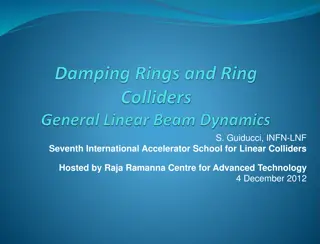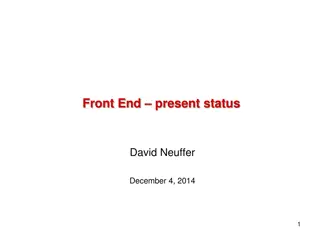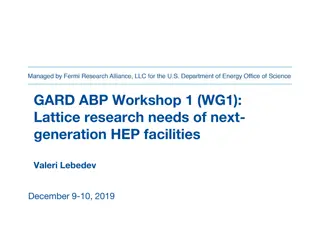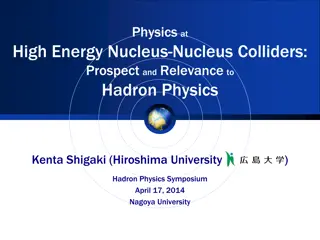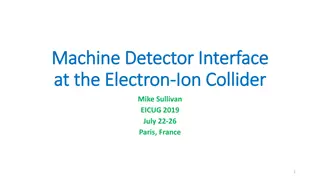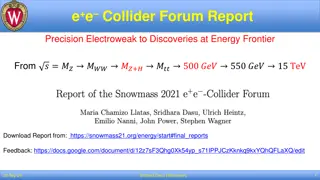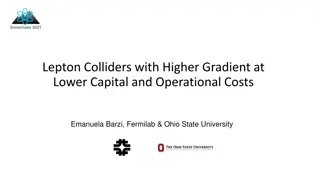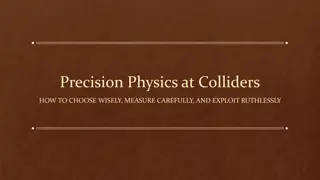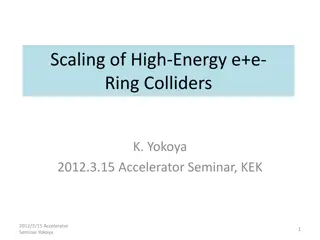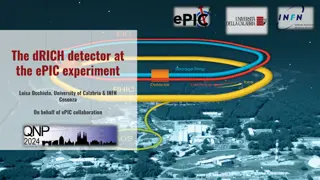Overview of CAIN Particle Tracking Code for High-Energy Colliders
CAIN is a particle tracking code used for high-energy collider simulations since 1984. Initially named ABEL, it evolved to include beam-laser interactions for gamma-gamma colliders. The code, written in FORTRAN 90, handles beam-beam and external fields, with a structure where all particles are stored in a single array. Mathematical expressions, commands, and beam definitions are key aspects, with polarization and spin considerations included. The code handles Courant-Snyder parameters for beam definition. Although not actively revised, the manual and code versions are available.
Download Presentation

Please find below an Image/Link to download the presentation.
The content on the website is provided AS IS for your information and personal use only. It may not be sold, licensed, or shared on other websites without obtaining consent from the author. Download presentation by click this link. If you encounter any issues during the download, it is possible that the publisher has removed the file from their server.
E N D
Presentation Transcript
CAIN Kaoru Yokoya 2021.09.30 IDT-WG3 Manual CAIN244bmanual.pdf and FORTRAN source file Cain244b.zip are uploaded to the indico site https://agenda.linearcollider.org/event/9396/
Versions Started in 1984, named ABEL, for beam-beam interaction in JLC Pinch effect Beamstrahlung Later, renamed to CAIN when beam-laser interaction was included for gamma-gamma colliders Latest version: not clear. Perhaps, CAIN2.44b, but a beta version CAIN2.43 is better Code Written in FORTRAN90 since recursive calls were included Windows version and UNIX version I have almost stopped revising the code. Ask Tauchi san for UNIX version and compilation Manual available. Uploaded to today s indico page Possible bugs Sometimes a strange phenomena when too many macroparticles are used Routines which are used only rarely
Structure of the Code All the particles (electron, positron, photon) are in one big array, containing the info of the space-time, energy-momentum, polarization, etc. Fields Beam-beam field External field (constant field, quadrupole field, laser field)
Math Simple arithmetic can be done in the input file Variables Can use numerical variables, character strings, arrays Pre-defined variables such as Pi, Emass Expressions Arithmetic, logical Pre-defined functions Sin, Exp, Log, BesJ, etc.
Commands Math expression SET, ARRAY Control : DO, CYCLE, EXIT, ENDDO, IF, ELSEIF, ELSE, ENDIF Output WRITE, PRINT PLOT (use very old software TOPDRAWER) Beam definition BEAM LASER Interaction control BBFIELD beam-beam field LASERQED CFQED beamstrahlung, coherent pair creation, LUMINOSITY PPINT (incoherent pair) Beamline MAGNET, BEAMLINE, BLOPTICS, MATCHING TRANSPORT, ENDTRANSPORT Execution PUSH, ENDPUSH DRIFT
Polarization Spin of electron/positron and Stokes parameters of photons Treated as density matrix But not for all the interactions L : Longitudinal spin of electron/positron (or circular polarization of photon). T : Transverse spin of electron/positron (or linear polarization of photon). * : 100% polarization only N : Not computed. (No change for existing particles, zero for created particles) - : Irrelevant
Beam Definition Courant-Snyder parameters: Following parameters can be used Beam data can also be read from files CAIN standard format, MATHEMATICA format, FORTRAN NAMELIST) Or, user-defined format (see Sec.3.5.2 of the manual
Beam-Beam Field Longitudinal slices No interaction between different slices (Lorentz contraction) Longitudinal mesh size must be defined by the user Interaction within each slice (2D) Main part Equal-space, rectangular mesh Kernel potential averaged over a mesh Fast computation by FFT Outside region Ignore the contribution of the particles outside the mesh region But the force from the main part to outside partcles is included by either direct Coulomb force or by harmonic expansion (see Sec.5.7 of the CAINmanual244b for more detail) Size of the main part and the mesh size are decided by the input data, not automatically.
Beamstrahlung Use the formula in constant (within the slice) magnetic field Emission angle is not taken into account Polarization Initial and final electron polarization (longitudinal and transverse) and the Stokes parameter of the final photon are included So, the actual formula is much more complicated than above Special functions such as ??5/3 and ?2/3 are approximated by appropriated polynomials
Coherent Pair Creation Constant field formula Polarization of (e+, e-, ) is included The formula is much more complex than above Creation angle ignored The algorithm is inefficient for large (>~ 1000)
Incoherent Processes Included processes Breit-Wheeler Bethe-Heitler Landau-Lifshitz Bremssstrahlung Breit-Wheeler process Formula including circular polarization of initial photons is used Other processes are reduced to Breit-Wheeler by the virtual (almost real) photon approximation, i.e., Bethe-Heitler + e-+ e+ Landau-Lifshitz + e-+ e+ Bremssstrahlung e + e + where is the virtual photon These low energy pairs are somehow tracked Use the exact formula of motion in a constant field (special mesh size is not introduced) Time consuming See Sec.5.11 Incoherent processes of the manual + e-+ e+ + e+- e+-+ e-+ e+ e + e e + e + e-+ e+ e + e e + e +
Beam-Laser Interaction Laser intensity parameter Often denoted by ? (plasma) or ? (undulator) The laser is treated as an external field, but the created photons are treated as particles Laser field is defined by the parameters such wavelength, Rayleigh length, power density, Stokes parameters, profile (Gaussian, trapezoidal, cutoff, etc) Processes Laser-Compton Laser-gamma (Breit-Wheeler process between laser and gamma)
Laser-Compton Formulas expanded by Bessel functions are used Valid for any in principle but the convergence is poor for large . Actually, ~ 3 is the limit. Laser-Compton was introduced to CAIN because of the gamma-gamma collider. up to 1 was enough. Sometimes QED people want very large , but CAIN cannot treat such a case. I cannot find a good formula for large . Can also be used to simulate the radiation by electron/positron in undulators Polarization Initial and final electron helicity Final photon helicity Laser polarization Must be either 100% circular or 100% linear This case has not been checked well Written for an experiment at BNL many years ago Unpolarized laser impossible TDL (times diffraction parameter) is adopted by physics is not clear Linear Compton formula can be used for very small Treated as particle-particle interaction Almost all polarizations are included
Laser Breit-Wheeler Similar to laser-Compton (different channel) Introduced also for gamma-gamma collider Photons created by laser-Compton can disappear by pair creation in the same laser Bessel function expansion Poor convergence for large No linear polarization of the laser
Outputs Particle list To a text file At any time during the collision Interaction proceeds as a loop of PUSH command as PUSH Time=(tini, tfin, nstep) any commands can be inserted ENDPUSH Graphic output Only to for the very old software topdrawer developed > 40 years ago You have to create graphic data unless you have topdrawer Luminosity Any combination of particle species ( , e+, e-) for right/left going For Topdrawer or numerical table Helicity can be separated
What else is needed? A few years ago, Daniel Jeans asked me if physics events can be generated during the collision simulation. This makes it possible to generate events with the vertex position recorded. CAIN2.44b introduced an operand PPDATA=nf of the LUMINOSITY command. Then, CAIN writes particle info (energy-momentum, space- time, etc.) at any close encounter of 2 particles on the file #nf. However, this will create a huge file (> several hundred Giga bytes). Not very practical. For that purpose, perhaps, you have to edit the subroutine PPINT in the source file.
What else is needed? (continued) Big fix for large number of macroparticles This is hard Very large Upsilon or ? Angle of beamstrahlung? Compton scattering (not as laser-Compton)? Laser with very large .




